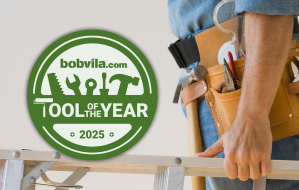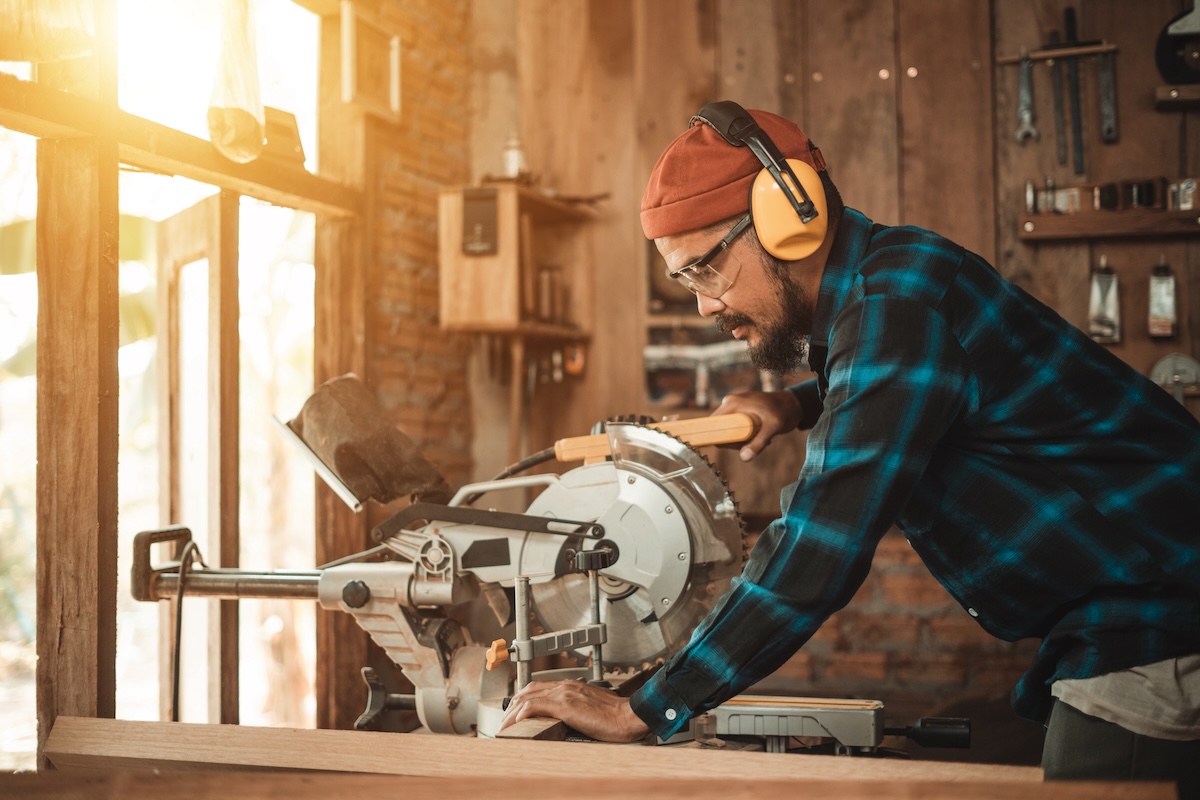

We may earn revenue from the products available on this page and participate in affiliate programs. Learn More ›
Power tools make construction and maintenance work faster, easier, and—let’s face it—a whole lot more fun. Who wants to wrestle with a manual screwdriver when a power drill gets the job done in seconds, all while making you feel like a boss?
These mechanical marvels help us take on jobs that would otherwise be too time-consuming, physically demanding, or simply impossible with hand tools alone. From building a fence, to repairing drywall, to trimming hedges, power tools enable you to work quickly and accurately, turning complex tasks into manageable projects.
Power tools are indeed powerful, but they also can cause serious harm if not used safely. When it comes to equipment or tools that twist, cut, or grind, it can only take a momentary malfunction or lapse in focus to be seriously injured.
According to the U.S. Consumer Product Safety Commission (CPSC), injuries related to power tools are unfortunately commonplace. In one year, more than 418,000 emergency room visits were linked to power tools and workshop equipment. So understanding power tool safety is essential for every DIYer.
This article breaks down the hazards related to common DIY power tools and offers expert-backed tips for protecting yourself and others while using them. Take these safety tips to heart so you can finish your next project with pride, and all fingers intact.
Recognize the hazards.
As exciting as it is to bring home a shiny new power tool, it’s critical to understand how it can hurt you before you use it. Power tools and equipment can expose you to a variety of health and safety hazards, some of which aren’t obvious.
Health hazards are risks that affect your body over time. These may include:
- Hearing loss from prolonged exposure to loud noise
- Nerve damage from vibrating tools
- Lung damage from dust and fumes
Most of the time, though, we associate power tools with safety hazards—risks that cause immediate injury, such as:
- Cuts and lacerations from sharp edges
- Eye injuries from flying debris
- Shocks or electrocution from damaged cords or wet conditions
- Fall injuries from power cords or unstable footing while using tools
- Crush injuries from moving parts that trap fingers or clothing
These types of injuries can happen fast, without warning.
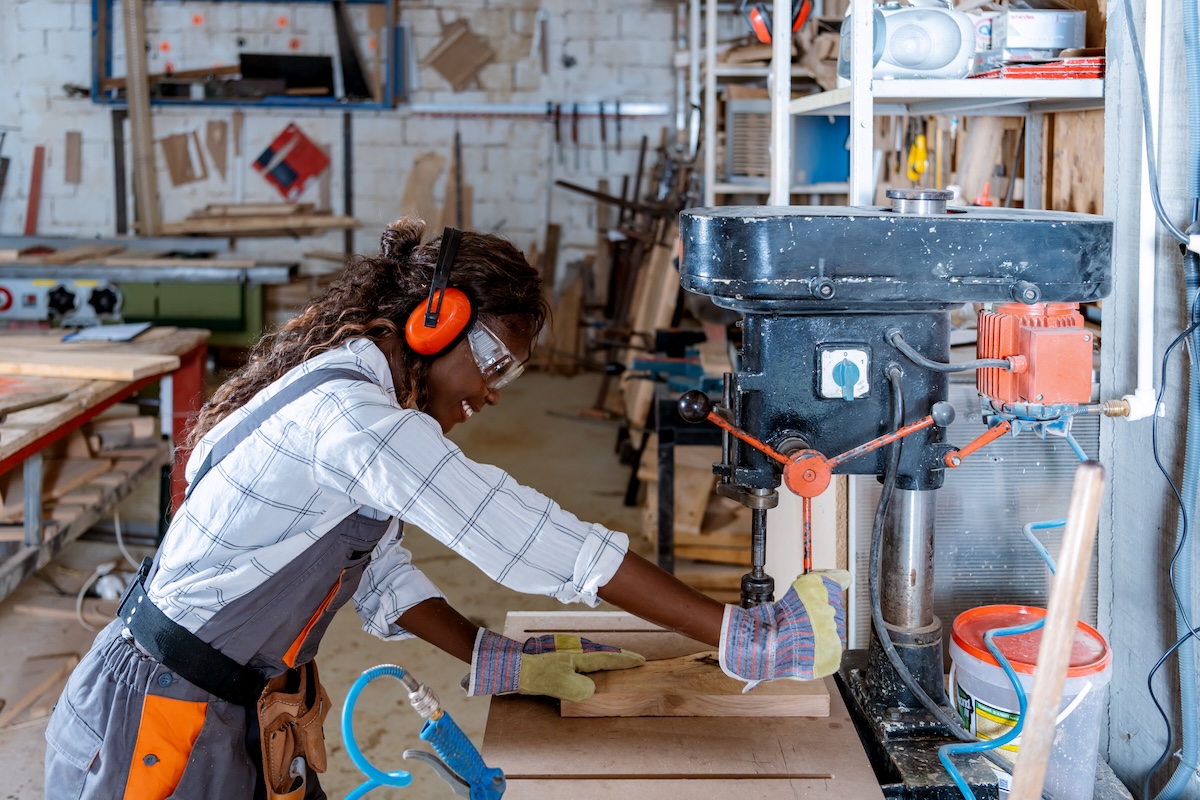
Know the tool and what it does.
In many cases, the specific hazards of a power tool depend on the type of tool it is. Home tool sheds usually contain a variety of tools and equipment, and each type poses different hazards.
We’ll take a closer look at six of the most common household power tools later. For now, keep in mind that most DIY tools fit into one of these categories:
- Cutting tools, like circular saws, jigsaws, table saws, and reciprocating saws. The sharp, fast-moving blades on these tools can cause cuts and lacerations. They can also send flying debris into the air.
- Drilling and fastening tools, like drills, impact drivers, screw guns, and hammer drills. These tools can cause puncture wounds and injuries from flying debris. Their torque can cause sudden twisting, causing wrist or shoulder injuries.
- Grinding and sanding tools, like angle grinders, orbital sanders, and belt sanders. These tools produce flying particles and dust that can harm eyes and lungs. Their high-speed rotation can also cause kickback injuries.
- Pneumatic tools, like nail guns, air compressors, and staplers. Pneumatic tools can cause puncture wounds and injuries from high-pressure air.
- Lawn and garden tools, like hedge trimmers, lawn mowers, and chainsaws. These tools can cause cuts, kickback injuries, and harm from flying debris.
The first step to using a tool safely is understanding what it does and what could go wrong. Many injuries happen because the user didn’t fully understand the tool they were using. So before you power up, ask these questions:
- What does this tool do?
- How does it move?
- How can it hurt me?
- What could go wrong?
Get educated.
Knowing what the tool does is one thing, but knowing how to use it correctly is another. Before you turn a tool on, take the time to learn how it’s meant to be used.
That starts with reading the manual, as dry a task as that may be. “Get educated,” says Mike German, owner of Handyman Connection in Parker, Colorado. “Watch safety videos and check the manufacturer’s instructions and website.” Many brands have user-friendly short instructional videos or quick-start guides on their websites.
Will Pemberton, a personal injury and construction accident attorney in Madison, Wisconsin, echoes this advice. “It’s a huge mistake to skip reading the manual of instructions,” he says. “Lack of understanding combined with user error, lack of proper supervision, or safety planning are all common threads that lead to injuries on DIY projects.”
German also recommends checking product reviews from trusted sources and talking to experienced staff at hardware stores for advice and safety tips.
It doesn’t take much to cause permanent hearing loss from a power tool, and it’s very easy for a chip or splinter or debris to fly from your power tool into your eye.
Mike German, Handyman Connection
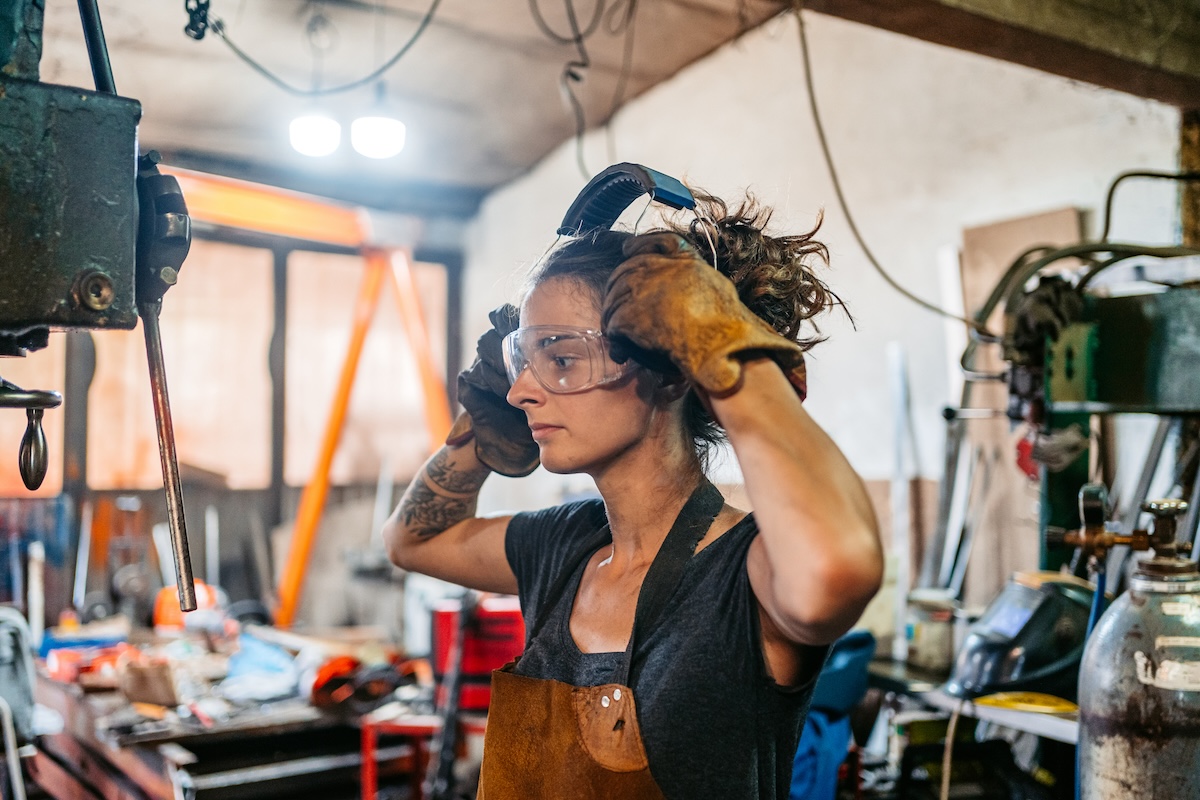
Wear the proper PPE.
Even with education and training on proper tool use, accidents can still happen. For that reason, personal protective equipment (PPE) is essential. Depending on the type of work you’re doing, the proper PPE could include:
- Safety glasses or goggles to protect eyes from flying debris
- Earplugs or earmuffs to protect your hearing when operating loud tools
- Dust mask or respirator to protect your lungs when cutting or grinding
- Gloves to protect your hands when handling rough or sharp materials—but not when using tools with spinning parts, as gloves can get caught
German emphasizes that PPE is not optional. “Don’t disregard safety by being macho. Use eye and ear protection even when you think you don’t need it,” he says. “It doesn’t take much to cause permanent hearing loss from a power tool, and it’s very easy for a chip or splinter or debris to fly from your power tool into your eye.”
Use the tool the way it’s designed.
It can be tempting to use a tool in a way it’s not meant for if you’re tight on time or don’t feel like making another trip to the hardware store. But that’s a surefire way to get hurt. When tools are misused, they’re put under strain they weren’t built to handle, and their safety features can’t work properly.
For example, using a wood-cutting blade on a circular saw to cut metal can cause the blade to overheat or even shatter, putting you and anyone nearby at risk of serious injury. Even very common tool improvisations, like using a pry bar as a hammer, can significantly increase your risk of injury due to loss of control, tool slippage, or wrist strain from improper impact.
Pemberton notes, “Most of the time, injuries involving power tools are caused by improper use of the tools. They may be using the wrong tool to get the job done, which happens frequently.”
If the tool isn’t designed for the job, don’t use it. Get the proper tool, or wait to do the job until you can.
Don’t skip inspection and setup.
Set your project up for success by taking the time to inspect your tools and set up your workspace properly.
- Examine each tool before using it. Look for cracks, loose parts, or frayed cords. Never use a tool if it’s damaged. Ensure safety features, like guards, are in place and functioning properly. Never remove safety features from tools to get the job done faster—it’s not worth the risk!
- Set up your workspace. Practice good housekeeping by clearing the work area of clutter and loose cords. Ensure you have stable footing, especially when working outdoors or on uneven surfaces. Give yourself enough space so that you can maintain good posture and balance while you work, and use both hands to control the tool whenever possible. Never use electric tools in wet conditions.
Take care of your tools.
Well-maintained tools last longer and save you money. But more importantly, they are much safer to use. Neglected, rusted, or damaged tools are much more likely to fail or cause injury.
Get the habit of putting your tools away when you’re done, and store them somewhere safe and dry, where they’re not exposed to the elements. Coil cords neatly.
Maintain cutting tools by keeping the blades sharp. Dull blades force the tool to work harder, increasing the risk of overheating and kickback.
Never carry a tool by the cord or hose, and always keep cords away from sharp edges and hot surfaces.
If a tool sounds strange, vibrates, or smells during operation, stop using it immediately. Always disconnect tools when not in use or when performing maintenance.
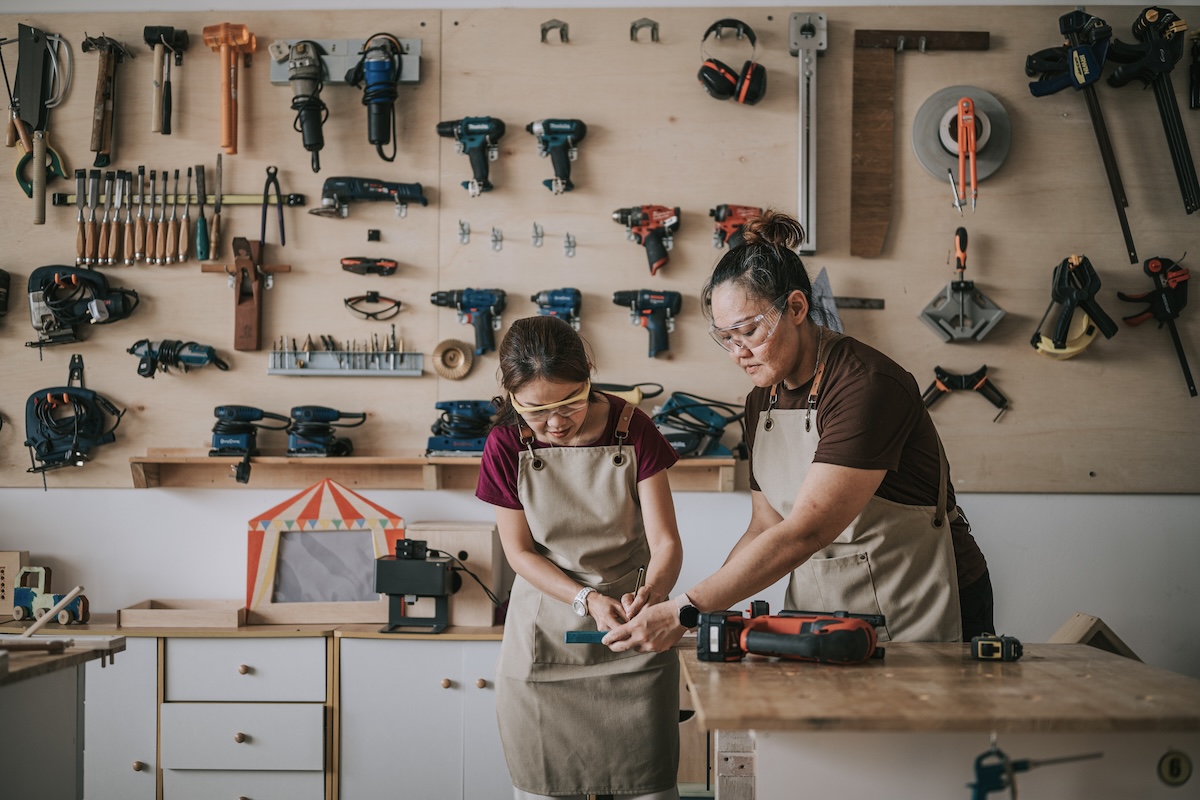
Know who’s at risk (it’s not just you).
Most DIYers may think about power tool safety in terms of avoiding injury, but it’s also important to think about liability. If someone gets hurt while helping you with a project, you could be held responsible.
Pemberton points out that many of the claims he sees don’t involve the person operating the tool. “From a legal standpoint, most claims don’t come from the homeowner themselves but from friends, family members, or neighbors who were helping out and got hurt,” he says. “These well-intended projects can quickly become liability risks when safety protocols aren’t followed.”
That liability often comes down to how the tool was maintained and whether the homeowner was aware of its condition. “Liability can arise when the homeowner knew—or should have known—the tool was defective or the conditions were unsafe,” Pemberton explains. “For example, if a neighbor borrows a saw with a missing guard, and the homeowner failed to warn them, the homeowner could face a negligence claim.”
As he puts it, “Liability often hinges on whether the homeowner took reasonable steps to prevent injury.” He adds, “This should be a reminder that safety should come first even when you’re not on a job site and you’re at home. Anyone helping you, whether it’s a friend or family, deserves the same caution you would show a hired professional.”
Know your limits.
You don’t need to be a professional contractor to use power tools safely. But you do need to know when a project or tool is beyond your limits. It’s better to pause a job and get help than to push ahead and get injured as a result. Not every project is a realistic or safe DIY.
German recommends assessing whether a project is within your skill level by checking to make sure you have the 3 Ts:
- Do I have the time to do this?
- Do I have the tools to do this?
- Do I have the technique to do this?
If the answer to any of those is no, it’s time to reassess whether this project or tool is right for you. As German puts it, “If you’re not sure what you’re doing, take a step back and get help.”
6 Common Power Tools and How to Use Them Safely
Understanding the basics of power tool safety for each of these common household tools can help prevent serious injuries and reduce your risk of harm.
Table Saw
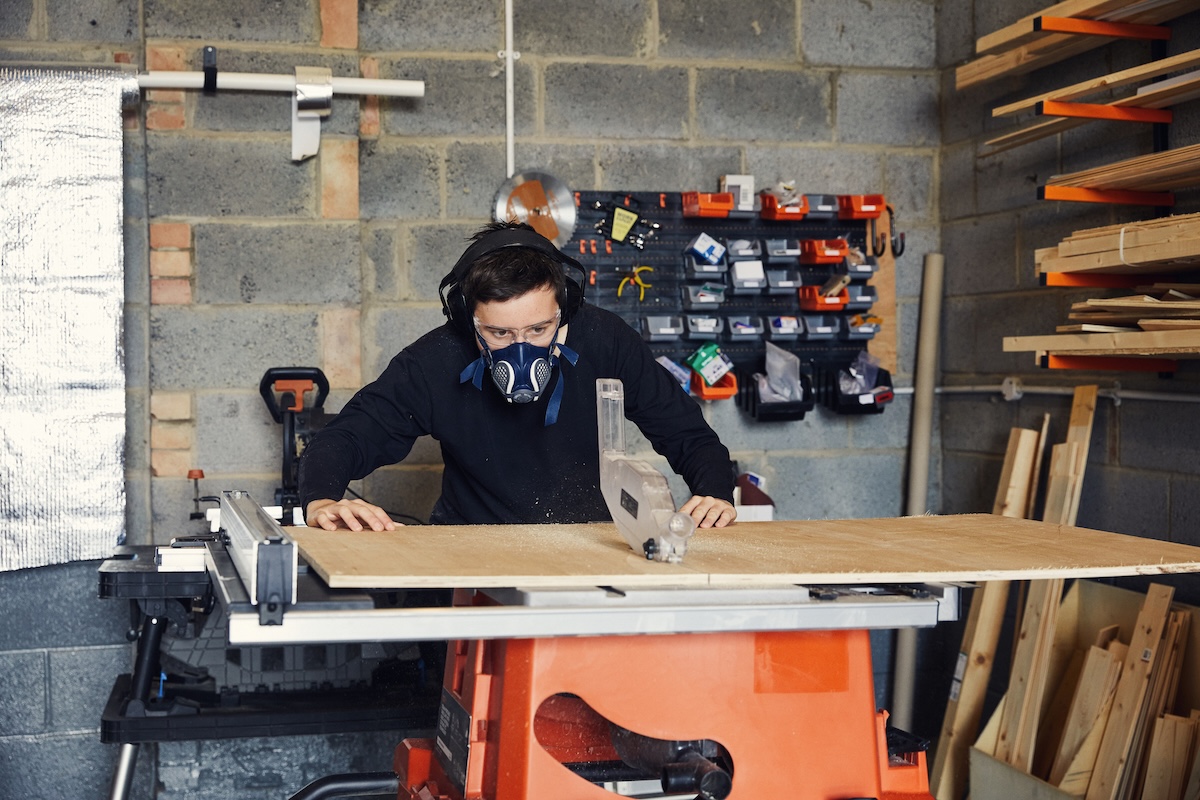
A table saw is a powerful woodworking tool that uses a circular blade to cut wood and other materials quickly and accurately. It’s one of the most efficient tools in a home workshop, and also one of the most dangerous. A 2014 CPSC study reported nearly 80,000 emergency room visits over 2 years due to table saw injuries.
Pemberton notes that power saws, including table saws, are among the tools most frequently involved in legal claims tied to DIY injuries. German agrees. He states, “In my experience, a table saw can pose the greatest damage if you’re not prepared.”
The main hazards of table saws are:
- Contact with the spinning blade, causing severe lacerations or even amputation
- Flying debris, causing eye injuries
- Kickback, when material is thrown back with force, pulling the user’s hand toward the blade
To reduce your risk of harm while operating a table saw:
- Wear eye protection.
- Never remove the blade guard.
- Keep hands at least 4-5 inches from the blade.
- Use a push stick for narrow pieces.
- Never stand directly in line with the blade.
- Ensure that the riving knife or spreader is correctly adjusted.
- Use the correct blade height for the material you are cutting.
- Always wait for the blade to stop before reaching in.
Power Drill
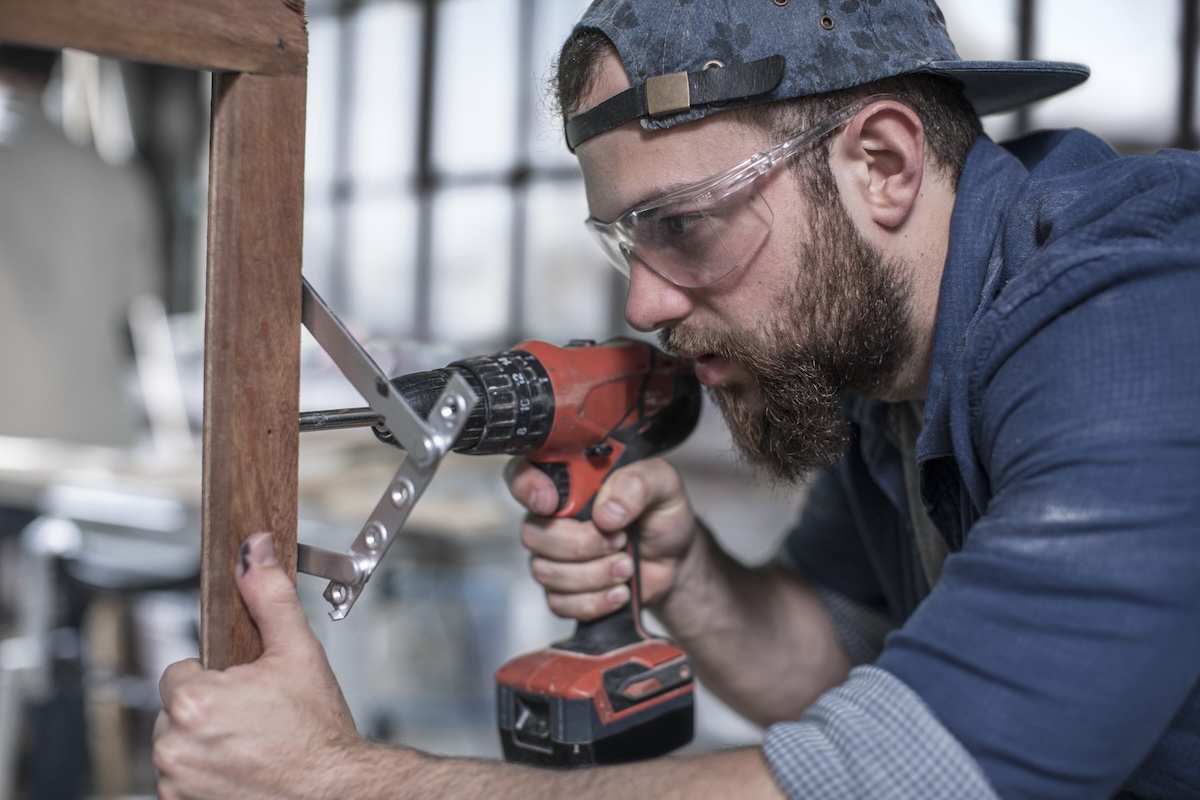
Power drills are used to drill holes in wood, drywall, metal, and other materials. Drills can also drive screws, mix paint, and polish surfaces with specific attachments. A drill is often the first power tool in a new DIYer’s collection. They are incredibly versatile and useful, but they are not risk-free.
The main hazards of power drills are:
- Flying debris, causing eye and skin injuries
- Puncture wounds
- Torque-related injuries, especially to the wrist and shoulder
To reduce your risk when using a drill:
- Wear eye protection .
- Use the right drill bit for the material.
- Hold the drill with both hands, if possible.
- Start slow and increase speed gradually.
- Keep long hair and loose clothing secured, as these can get caught.
- Never use a drill with a damaged cord, chuck, or bit.
- Always be aware of what’s behind the surface you’re drilling.
Nail Gun
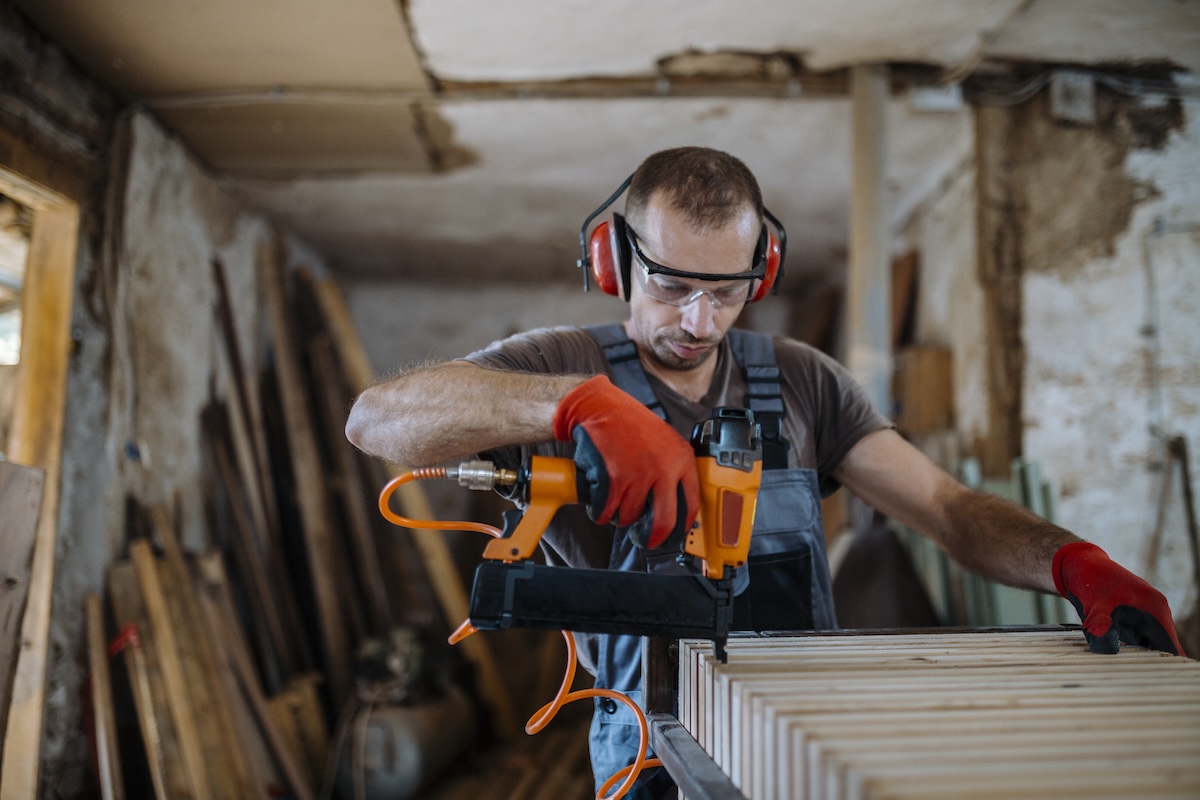
A nail gun drives nails rapidly into wood and other materials. It’s commonly used in framing, roofing, and finish carpentry. Nails guns may be pneumatic tools or fuel- or battery-powered. They’re speedy and efficient, but they can also pose serious risks if misused.
The Centers for Disease Control report that nail guns are responsible for about 37,000 emergency room visits each year. Pemberton also cites nail guns as a common tool linked to serious injuries in home construction projects. “Nail guns, often used in deck gilding of framing, can lead to deep lacerations or puncture injuries,” he says.
Hazards related to nail guns include:
- Puncture wounds
- Ricocheting nails
- Accidental discharge
- Hearing damage from repeated high-decibel firing
- Loss of balance, especially on ladders
To keep safe when using a nail gun:
- Wear hearing protection and high-impact eye protection.
- Never position the gun to point at yourself or anyone else.
- Keep at least 12 inches away from the nailing point.
- Avoid awkward positions or working above your head.
- Keep your finger off the trigger when holding or carrying the nail gun.
- Use the nailer only with your dominant hand.
- Use the full sequential trigger, not bump-fire.
- Never bypass or disable the safety-contact tip.
Hand Grinder
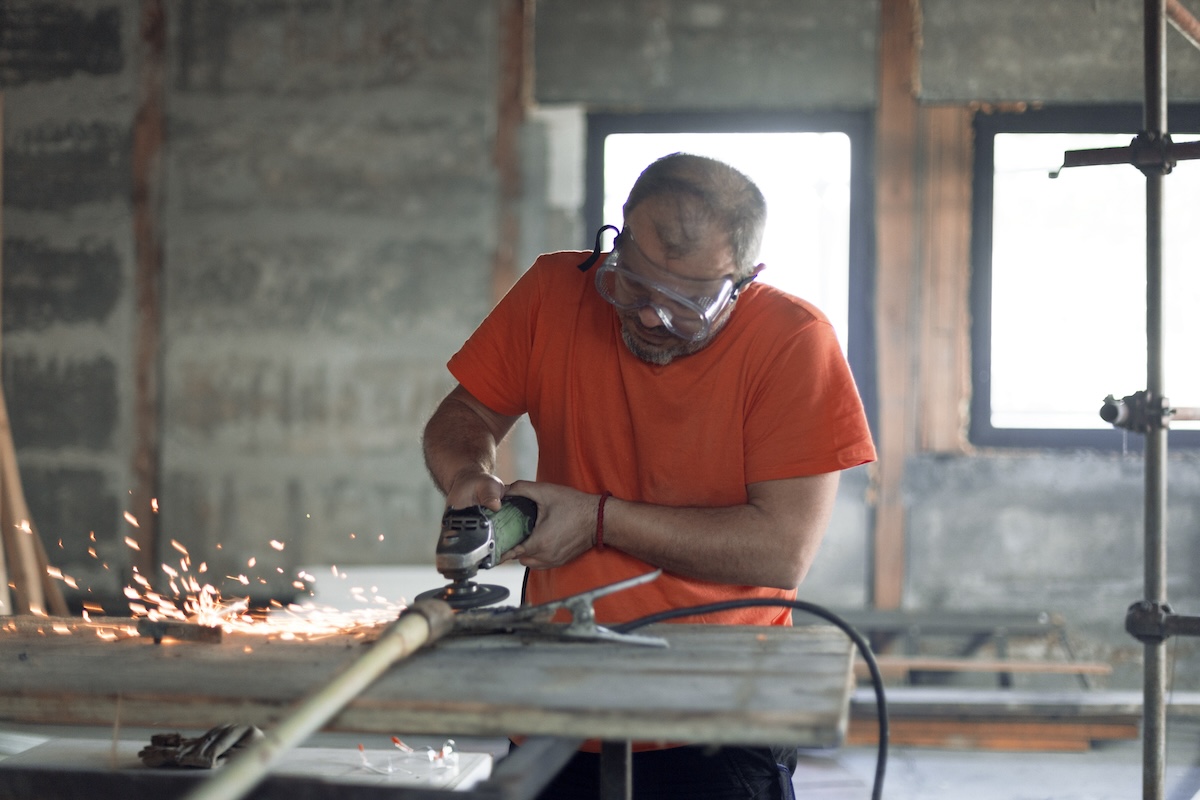
Angle grinders and other handheld grinder tools are used for cutting, shaping, and smoothing materials with their high-speed rotating disc. They can be electric, gas-powered, or pneumatic.
Common hazards from hand grinders include:
- Eye injuries from sparks or flying debris
- Cuts or abrasions for slipping or kickback
- Damage to lungs from inhalation of dust or metal particles
- Hearing damage
Here’s how to stay safe when using a hand grinder:
- Always wear eye, face, and hearing protection.
- Never use a grinder without a guard.
- Hold the tool firmly with both hands.
- Secure loose clothing and long hair.
- Always use the correct disc for the machine’s size and speed and the material you’re cutting.
- Let the grinder reach full speed before contacting the surface.
- Keep work area free of flammable materials.
Chainsaw
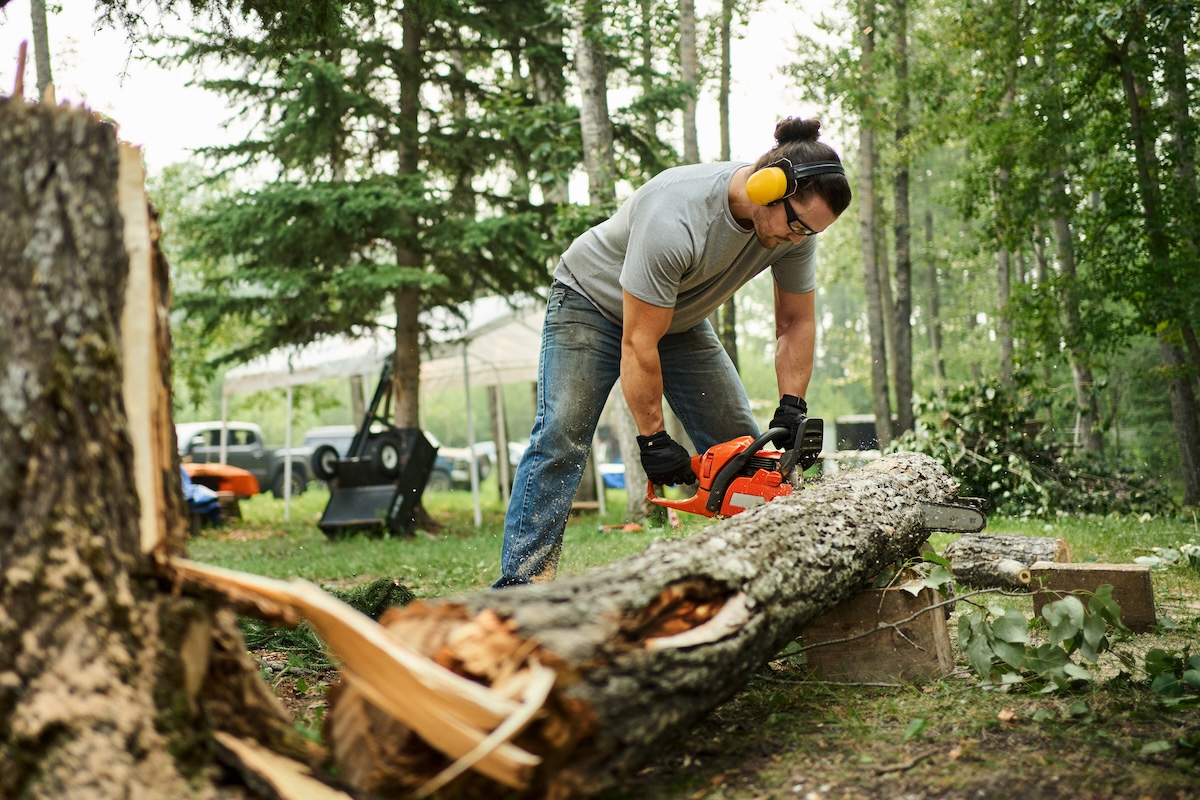
Chainsaws are powerful cutting tools that can make fast work of trimming and felling trees, cutting firewood, and storm cleanup. Their sharp, fast-moving blades and potential for kickback make them high-risk tools for serious injury, especially for inexperienced users.
Chainsaw hazards include:
- Deep lacerations and amputations
- Kickback injuries
- Falling branches or logs
- Hearing damage
- Vibration-related nerve damage
To reduce your risk of harm when using a chainsaw:
- Wear protective chaps, gloves, a helmet, face shield, and hearing protection.
- Always use both hands and maintain a firm grip, with secure footing.
- Never cut above shoulder height.
- Always be aware of kickback zones.
- Avoid cutting with the tip of the saw.
- Keep the chain sharp and properly tensioned.
Lawn and Garden Tools

Gardening and yard maintenance may be enjoyable and even good for your health, but it’s not without its risks. The CPSC reports that each year, about 230,000 people are treated in emergency departments for injuries related to lawn and garden tools. Many of these injuries are caused by outdoor power tools, such as lawn mowers, hedge trimmers, and leaf blowers.
Common hazards of lawn and garden tools include:
- Cuts and lacerations from sharp blades
- Eye injuries from flying debris
- Trips and falls from cords or uneven terrain
- Burns from hot engines or machine parts
- Hearing damage
To stay safe when using lawn and garden tools:
- Wear sturdy, closed-toe footwear and long pants.
- Wear hearing protection.
- Limit distractions to stay focused.
- Clear the work area of rocks, sticks, and other obstacles.
- Keep children and pets at a safe distance.
- Always wait for blades to fully stop before clearing jams.
- Regularly inspect tools and keep blades sharp.
